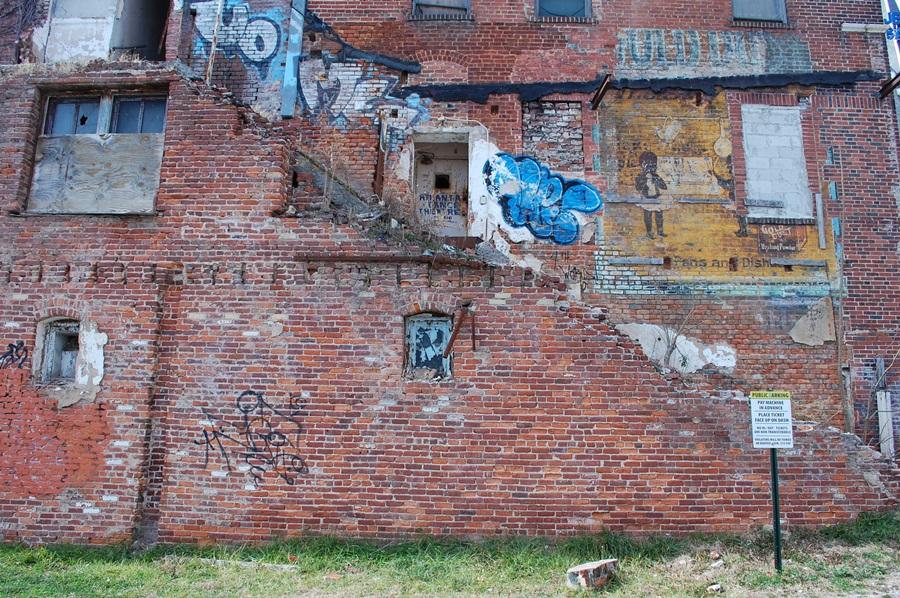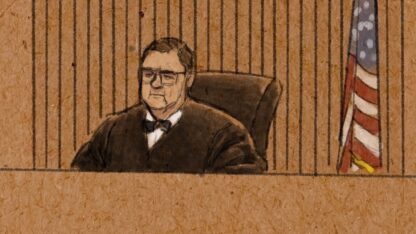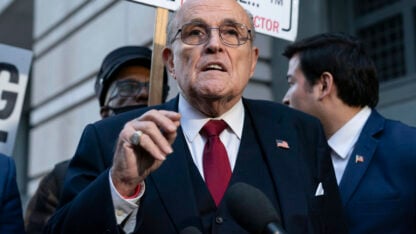“When I first saw it, I wasn’t sure what I was looking at,” Fann told me. “And I wasn’t sure if I liked what I saw.”
She showed me an old mural on the wall. It’s pretty faded, but you can see that it’s a painted advertisement. It features two small characters, dressed in pink tutus and washing dishes.They’re bodies are dark black. Their facial features are outlined in white.
“They’re kind of like minstrel figures, when whites would blacken their face and leave their lips white,” Fann said. “They’re not what we would consider today, very flattering.”
From the block letters at the top of the mural, you can make out two words ─ “Gold Dust.”
These two black figures, Fann told me, are the Gold Dust Twins.
Who are the Gold Dust Twins?
The Gold Dust Twins were advertising icons for a soap company called N. K. Fairbank, created to sell its Gold Dust Washing Powder.
According to Marilyn Kern-Foxworth, author of “Aunt Jemima, Uncle Ben, and Rastus: Blacks in Advertising, Yesterday, Today, and Tomorrow,” the Gold Dust Twins were around starting in about 1887, but they really took off after their appearance at the St. Louis World’s Fair in 1904.
As this ad campaign continued over the decades, the twins did all sorts of things, from playing the piano to flying an airplane, but to be sure, most of the time they were cleaning. Their slogan? “Let The Gold Dust Twins Do Your Work.” (Though, the tagline in the individual advertisements varied. In at least one, it asks, “Are you a slave to housework?”)
“They were on everything,” Kern-Foxworth said. “They were very, very well promoted.”
Kern-Foxworth told me that in the early 1900s just about every American would have known who the Gold Dust Twins were. At the peak of their popularity, the characters even made their way onto the radio dial, although, in typical 1920s fashion, white actors played the black twins. (Thank you to old time radio specialist Elizabeth McLeod for sharing a 1940 recreation of this 1920s radio show for the audio version of this story. The broadcast featured the original actors and originally aired on an NBC series called, “Behind The Mic.”)
African-Americans And Advertising In The Early 1900s
The Gold Dust Twins weren’t the only example of advertisers using images of black people to sell products. They had Aunt Jemima cooking up pancakes, Uncle Ben bringing Americans rice and Rastus helping sell Cream Of Wheat. (All three are mentioned in Kern-Foxworth’s book title above; although, she said if she could rename the book today, she would include the Gold Dust Twins.)
According to Emory professor Kimberly Wallace-Sanders, this was a very popular advertising technique between 1890 and the 1920s and 30s.
“What’s interesting is, if they’re not in the kitchen, it has something to do with cleaning,” she said. “It’s all about racist depictions of blacks as inherently servile.”
But the Gold Dust Twins do differ from those other trademarks I listed in at least one way. While Aunt Jemima and Uncle Ben resemble real people. The Gold Dust Twins don’t really look human at all.
“They’re supposed to look industrious and strong, but I think they really are also meant to be humorous,” Wallace-Sanders said. “This is a big thing for this particular time period, is to find racist depictions of blacks really funny.”
Of course, it doesn’t seem very funny now. And it wouldn’t have seemed funny to African-Americans at the time. But then, they weren’t the targets of these advertisements.
According to Wallace-Sanders, advertisers were hoping to reach one demographic: white housewives. At this time, she said, African-Americans weren’t seen as consumers. (Interesting fact I learned from Marilyn Kern-Foxworth: the first time an African-American was featured in an advertisement in a non-stereotypical way was in 1964.)
Sometime around the 1930s, the Gold Dust Twins’ popularity did start to fade, but it’s not entirely clear why. As the country edged toward the civil rights movement and public opinion changed, it’s possible that the soap company just couldn’t keep up. In any case, today the Gold Dust Twins have been just about forgotten.
The Gold Dust Twins On A Changing Auburn Avenue
Forgotten maybe everywhere except Auburn Avenue. Though it’s worth noting again, that the Gold Dust Twins only survived here because they were hidden by another building for more than eighty years. Now with that building gone, the twins’ reappearance in the neighborhood has been met with mixed reviews.
Janis Perkins, who owns the Odd Fellows building across the street from the advertisement, said she didn’t realize it was there until a little over a year ago.
“I started seeing people coming by and taking pictures of it,” she said. “Then when I got closer to it and saw what it was, that’s when I realized, ‘Oh I’ve heard my mother say something about that.’”
Perkins came to Auburn Avenue in the 80s, after the street had already suffered from years of decline. Recently, though, she’s seen it start to bounce back. It’s even included on Atlanta’s new streetcar route.
With all these changes, Perkins doesn’t think the mural should be sitting on a wall without any sort of explanation of what it is.
“I don’t feel that it’s lending anything to the neighborhood,” she said. “And it’s maybe a sour note in your mouth when you see it.”
Matthew Garbett noticed the mural a few years ago when he lived in the neighborhood.
“I still don’t know how I feel about it in the long run,” he said. “You know, I’ve looked at it hundreds of times now. Every time I walk by it and every time I’m walking with people, I make them look at it.”
Like most people I talked to, he was surprised by what he saw. But then he learned the history behind the Gold Dust Twins advertisement, and, although it’s disturbing, he thought it should be preserved. At the very least, for the discussions about race relations and advertising that it can spark.
“It just becomes a fascinating little 8-by-8 piece of wall,” he said.
Back in 2013, Garbett, then the president of the Fourth Ward Neighbors association, talked with the Atlanta Preservation Center about what it would take to preserve the mural. At the time, he wasn’t able to get the project off the ground. But he did say after talking with me that he wants to look back into it.
One interesting thing to note: In the six or so years that the mural has been uncovered, graffiti artists and taggers haven’t touched it.
The Building Is “Too Far Gone”
Ultimately, any conversation about preserving the mural will have to include the owners of the property. Today it’s in the hands of the Butler Street Community Development Corporation, which until a few years ago was the Butler Street YMCA.
“We have a challenge with that building ─ the old Atlanta Life building ─ because it is in very, very bad shape,” Rebecca Johnson, a board member of the Butler Street CDC, said. “I think we would love to save it. But I just think it’s too far gone.”
While the 2008 tornado didn’t destroy the nearly-hundred-year-old building, Johnson said there was enough damage to seal its fate.
But even if the building is demolished, there’s a chance the Gold Dust Twins will still be saved.
“All of us have said all along that we must find a way to preserve the Gold Dust Twins,” Johnson said. Although the Butler Street CDC hasn’t found that way just yet. (Johnson said the organization is open to ideas).
It wouldn’t be the first time an old painted advertisement was saved for its historic value.
Preservationists call these murals “ghost signage” and, in some cities, like Philadelphia and Albany, people have worked to restore them.
———-
The story behind the Gold Dust Twins isn’t one that’s easy to swallow. Yet, everyone I talked to for this story agreed that the mural should be preserved in some way, either on Auburn Avenue or in a museum. Most of all, they think it needs to be put in its historical context.
“To me, it is a gift to Atlanta,” Velma Fann, who first showed me the advertisement, said. “It’s an asset. It gives us something as far as history and tourism to point to and talk about. So let’s keep them. They’ve been hidden long enough.”
For now, at least, the faded advertisement is in plain view, visible to anyone walking or taking the city’s new streetcar.
On its route up and down Auburn Avenue, the streetcar passes a mural of John Lewis. And then the Gold Dust Twins.









